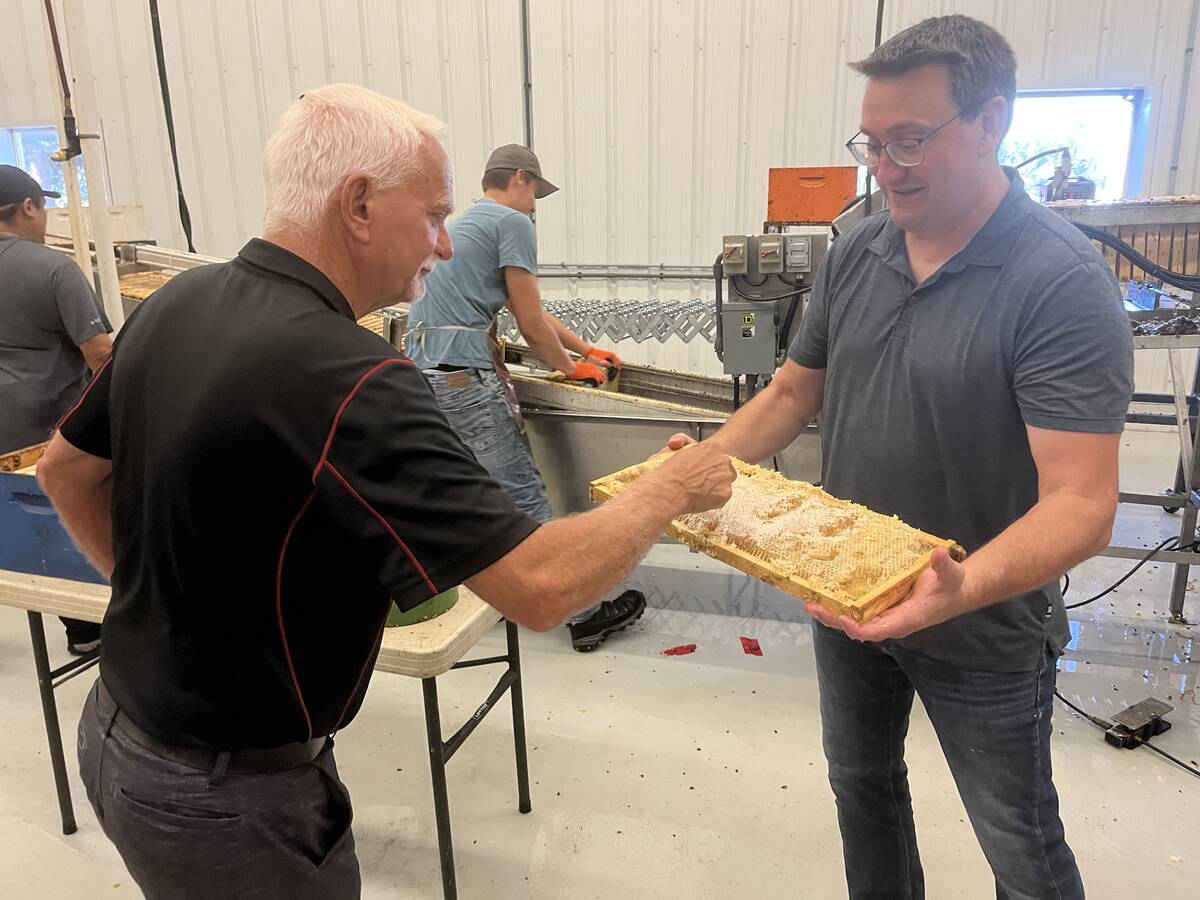A few years ago, I fell on the weighscale beam when I was trucking grain.
I remember trying to call home for help. However, I was the only one in the yard. Then I called our cellphone for help. It took me a few minutes to sort out how to contact my husband Don.
I was thankful I had a cellphone, but it would be even better if every farm worker had a cellphone with all the numbers programmed into it, to make it easy to contact help. These ICE (In Case of Emergency) numbers programmed into my phone would have been helpful to me.
Read Also

Alberta honey business ‘thrives’ despite bumpy beginnings
Thrive Honey showcases its honey production in market where Alberta produces 40 per cent of all honey produced in the country
Transport Canada advises against cellphone use while driving, saying the distraction increases the risk of collisions. Many provincial laws prohibit cellphone use while driving.
Whether a law or not, it is prudent for drivers to pull over to a safe place and stop before talking on their cellphones. The other option is to have a passenger take the call or let it go to voice mail.
For people who argue that they are capable of doing two tasks at once, the question is whether they can do so without decreasing the performance of one or both tasks.
I discussed this with my daughter who is studying “attention” in a Ph.D. program at the University of British Columbia.
Research studies about dividing your attention between two or more tasks indicate that it is difficult to maintain performance. In most cases, divided attention is considerably worse than when focused on one task. In the case of driving, reaction times may be delayed.
Are other distractions inside the vehicle, such as carrying on a conversation with a passenger, as distracting as cellphone use? That depends on the people involved. One sure advantage the passenger has over a caller is that the passenger can also see the world you are interacting with.
For your own experiment, the next time you are a passenger in a vehicle, notice how conversation pauses or slows when the driver is turning at a busy intersection or attempting to pass a vehicle.
The lulls or pauses in a conversation indicate that the passenger is aware of the environment outside the car – something a person on the other end of the cellphone cannot adapt for.
Sources: Sensation and Perception by S. Coren, L.M. Ward, and J. T. Enns, UBC., Cognitive Neuroscience: The Biology of the Mind by M. S. Gazzaniga, I. B. Ivry, and G. R. Mangan.
Birthdays with Toddlers
We’ve just returned from our grandsons’ first birthday parties.
Reid’s birthday is first, and I celebrated with him and his little buddies in Vancouver.
For birthday cake, my daughter Marla and I made carrot cupcakes with a cream cheese icing, sweetened with apple juice and colored with pureed blueberries.
The adults preferred the recipe below with the icing sugar, but the children ate the softened cream cheese/juice blend.
Ben, my son-in-law, arranged them in the shape of a caterpillar, with shoestring licorice legs. We used a recipe that Marla got from her maternal grandma, and adapted it to have less sugar for the little ones.
The next day we flew to Calgary to celebrate Leif’s birthday with him.
How adorable that was, watching the two little boys be together, four days apart in age, with two unique personalities that are already observable at one year old. It is priceless for Don and I as grandparents to enjoy this experience.
Carrot CupCakes
1 c. flour 250 mL
1/2 c. white sugar 125 mL
(1/4 c. white sugar 60 mL for kids)
1 tsp. baking soda 5 mL
1 tsp. baking powder 5 mL
1 tsp. cinnamon 5 mL
1/2 c. oil 125 mL
2 eggs
1 1 / 2 c. shredded carrots 625 mL
1 tsp. vanilla 5 mL
Mix the dry ingredients together and form a well in the centre for the oil and eggs. Mix. Add shredded carrots and vanilla and mix. Fill cupcake liners two-thirds full, and bake at 350 F (180 C.) for 15-20 minutes, or until done.
Cream cheese Icing:
1/4 c. butter 60 mL
1/2 c. cream cheese 125 mL
2 c. icing sugar 500 mL
1/2 tsp. vanilla 2 mL
Cream the cheese and butter and add icing sugar until appropriate consistency.
Add vanilla to taste.
Blueberry icing for kids
For the kids’ version of icing, we creamed the cream cheese, added about 1/4 cup (60 mL) of pureed blueberries for colour and apple juice for sweetener and spreading consistency.
Barbara Sanderson is a home economist from Rosetown, Sask., and a member of Team Resources. Contact: team@producer.com.

















